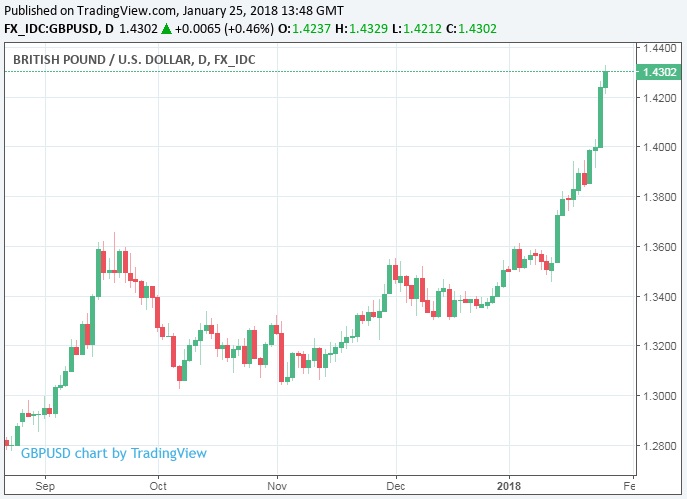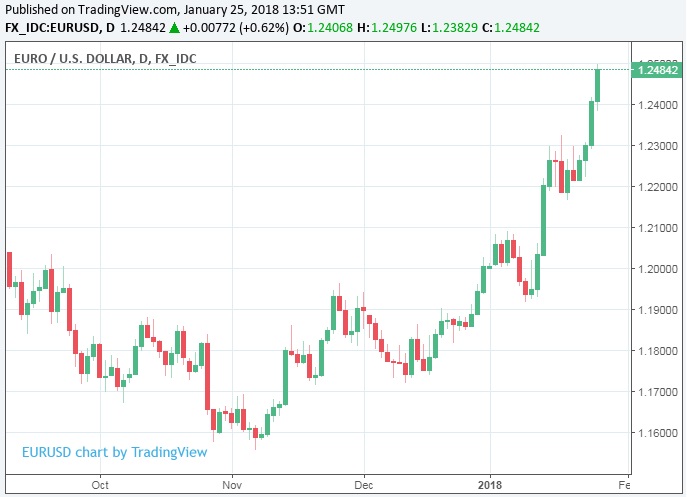Dollar Decline set to Continue as Investors Cycle on to Better Returns Elsewhere
- Written by: James Skinner

The US Dollar index has fallen 3.5% in January and is down by a double digit number over 12 months, but this is no surprise to some strategists, who are warning of more pain to come.
Extreme weakness in US Dollar exchange rates this January has heaped more losses on top of an already beleaguered currency, making the Dollar’s apparent fall from grace one of the hottest topics among analysts and pundits in recent days.
Losses for the US currency have pushed the continued meteoric rise of the Euro, and a strong recovery by Sterling, into the shade while kicking almost all other currency market happenings to the curb in the process.
The Pound Sterling is up more than 5% against the greenback this month while the Euro-to-Dollar rate has added 3.5%.
Such is the extent of the Dollar’s plight that previous underperformers like the Australian and New Zealand Dollars have also both gained 3.4% and 4% respectively over the US currency.
These losses have culminated in a 3.5% decline for the US Dollar index, taking the benchmark’s 12 month fall to -10.8%, and come against a backdrop of four year highs (2.66%) for US ten year Treasury yields.
There is a distinct absence of consensus between reports covering the source of the Dollar’s weakness as well as on the question of how long it might go on for. However, the greenback’s losses shouldn’t be a surprise for markets.
In fact, regular readers will know that a small group of strategists have been warning for months that further losses are in store for the US Dollar in 2018.

Above: Pound-to-Dollar rate at daily intervals. It has risen 5.4% in January alone.
Advertisement
Get up to 5% more foreign exchange by using a specialist provider to get closer to the real market rate and avoid the gaping spreads charged by your bank when providing currency. Learn more here.
“We think an orderly rise in US Treasury yields at the start of 2018 to the 2.60- 2.70% area – as the late-2017 corporate pension demand fades – does not need to trigger a broadly firmer dollar,” writes Chris Turner, global head of strategy at ING Group, in the bank’s 2018 outlook.
“And as the year progresses, we expect the Rest of World growth story to dominate and extend the benign dollar decline.”
The advanced stage of the US economic cycle has seen growth reach multi-year highs and has led to perceptions that the Federal Reserve interest rate cycle is maturing.
This means US interest rates and, in theory, bond yields may not be able to get much higher than their current levels. Meanwhile, faster US growth is fuelling the rest of the world’s economic expansion.
“The yield/fx relationship broke down in the second half of the 2004-2007 rate-hiking cycle, as the focus shifted from the Fed to (tighter) policy elsewhere,” says Kit Juckes, chief foreign exchange strategist at Societe Generale.
“That's a precedent which warns us that we may see a weaker dollar for the rest of this economic cycle.”
Current growth dynamics mean returns to investors are beginning to rise elsewhere in the world right at the point when many are beginning to wonder if the best days will soon be behind the US economy.
This could be driving investors to dump US Treasury bonds and the US Dollar at the same time, which might explain why the Dollar is falling at the same time as US yields are rising.

Above: Euro-to-Dollar rate at daily intervals. It is up nearly 4% in January alone.
“Take a step back to the 1990s and 2000s however and things look a lot less unusual. Back then, the correlation between US yields and the dollar was very weak,” chimes George Saravelos, an FX strategist at Deutsche Bank.
“FX market drivers were influenced by the complex interaction of macro variables, politics and valuations. The deviation between rates and FX was the norm, rather than the exception.”
Saravelos emphasises that currency market moves are ultimately dictated by flows of money moving from A to B, before flagging the generational shifts in asset allocations that took place among institutional money managers during the crisis years.
Europe was arguably the greatest victim of this shift, with American money managers pulling the plug on investments in Europe at such a rapid rate their position in the old continent fell to a record low as a share of assets.
Meanwhile, European investors also upped sticks and began funnelling money into foreign investment opportunities, in a process described by Saravelos as a recycling of the current account surplus. But now the tables appear to be turning and the tide is going into reverse.
“We would argue the medium-term bear market in the dollar started with the inauguration of President Trump and President Macron in the US and France, respectively, last year. It has coincided with a structural shift in the relative flow dynamics between the US and the rest of the world,” Saravelos writes.
“We continue to target 1.30 in EUR/USD for this year.”
Advertisement
Get up to 5% more foreign exchange by using a specialist provider to get closer to the real market rate and avoid the gaping spreads charged by your bank when providing currency. Learn more here.




